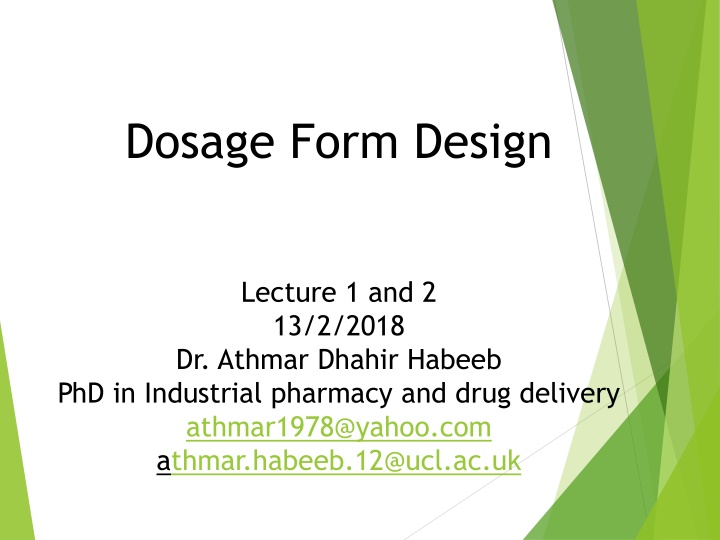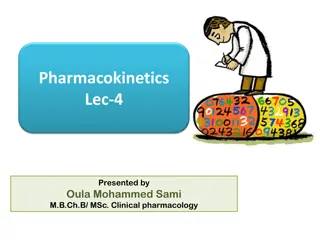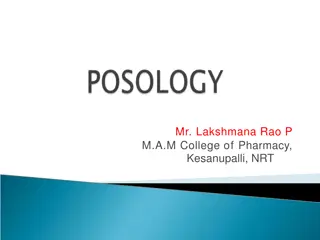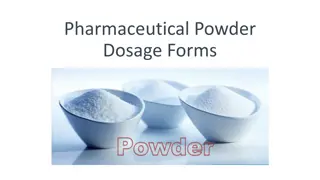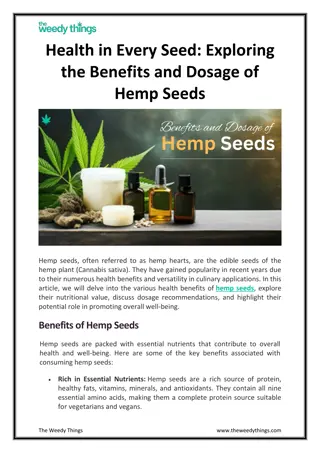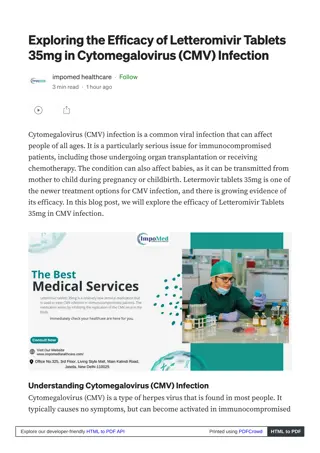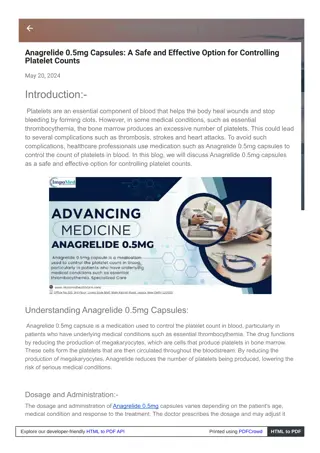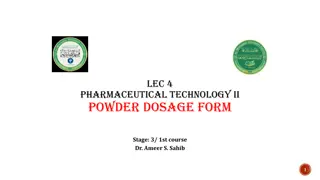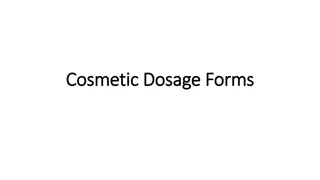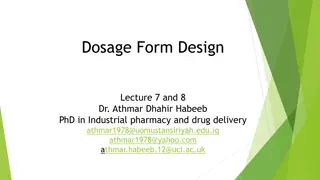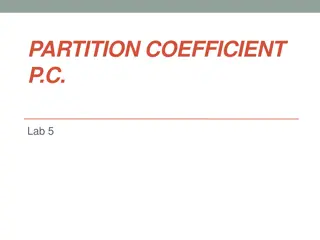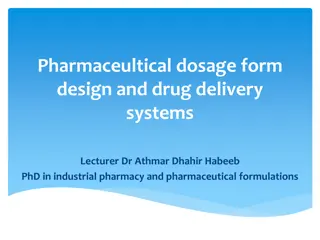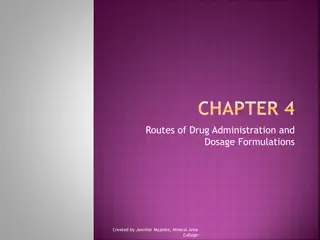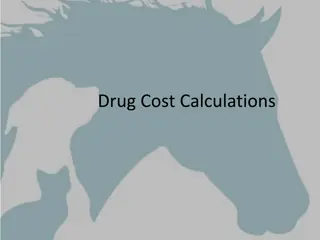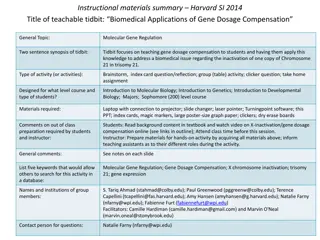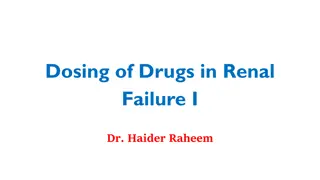Dosage Form Design
The process of dosage form design in pharmaceuticals, including considerations in biopharmaceutics and pharmacokinetics. Delve into the complexities of new drug development and approval, covering IND applications, clinical trials, drug discovery methods, and more. Understand the rigorous processes involved in gaining approval for marketing a new drug, from demonstrating safety and efficacy to adhering to quality standards. Learn about preclinical studies, FDA submissions, clinical trials phases, and postmarketing activities in the drug development journey.
Download Presentation

Please find below an Image/Link to download the presentation.
The content on the website is provided AS IS for your information and personal use only. It may not be sold, licensed, or shared on other websites without obtaining consent from the author.If you encounter any issues during the download, it is possible that the publisher has removed the file from their server.
You are allowed to download the files provided on this website for personal or commercial use, subject to the condition that they are used lawfully. All files are the property of their respective owners.
The content on the website is provided AS IS for your information and personal use only. It may not be sold, licensed, or shared on other websites without obtaining consent from the author.
E N D
Presentation Transcript
Dosage Form Design Lecture 1 and 2 13/2/2018 Dr. Athmar Dhahir Habeeb PhD in Industrial pharmacy and drug delivery athmar1978@yahoo.com athmar.habeeb.12@ucl.ac.uk
New drug development and approval process Current good manufacturing practices Dosage form design pharmaceutical and formulation consideration Dosage form design Biopharmaceutical and pharmacokinetic consideration
New drug development and approval process Objectives 1. Compare and contrast an Investigational New Drug (IND) Application from a New Drug Application (NDA) 2. Differentiate between Phase 1, Phase 2, Phase 3, and Phase 4 clinical trials. 3. Give examples of the sources of new drugs 4. Differentiate between the various methods of drug discovery 5. Delineate the circumstances whereby an old drug could be classified as new 6. Define pharmacology, drug metabolism, and toxicology 7. Explain a treatment IND 8. Define an orphan drug 9. Define a package insert and the information contained therein
New Drug Development and Approval Process To gain approval for marketing, a drug s sponsor (e.g., a pharmaceutical company) must demonstrate, through supporting scientific evidence, that The new drug or drug product is safe and effective for its proposed use. The various processes and controls used in producing the drug substance and in manufacturing, packaging, and labeling are properly controlled and validated to ensure that the product meets the established standards of quality. The process and time course from drug discovery to approval for marketing can be lengthy and tedious 1. 2.
A schematic representation of the process for new drug development New chemical entity sources Organic synthesis Molecular modification Isolation from plants Genetic Engineering Preclinical Studies including Chemistry Physical properties o Biological o Pharmacology o ADME o Toxicology Preformulation Investigational new drug application (IND) Submission FDA Review
CLINICAL TRIALS Phase I Phase II Phase III PRECLINICAL STUDIES (Continued) plus: Long term animal toxicity Product formulation Manufacturing and controls Package and label design NEW DRUG APPLICATION (NDA) Submission FDA Review Pre-approval Plant inspection FDA action Postmarketing Phase IV clinical studies 1. Clinical pharmacology/ Toxicology 2. Additional indications Adverse reaction reporting Product defect reporting Product line extension
Preclinical Research and development Clinical Research and development NDA Review Postmarketing surveillance Initial synthesis and characterisation Adverse reaction reporting Phase 1 Surveys/sampling testing Phase 2 Phase 3 Animal testing Short term Inspection Long term Average 1 years Average 61/2 years Average 7 years FDA 30-day safety review Average of approx. 15 years from initial synthesis to approval of NDA NDA submitted NDA approval Time course for the development of a new drug
What will happen after the discovery (e.g., synthesis) of a proposed new drug agent ??? Preclinical studies File an IND (Investigational New Drug) application with the FDA for initial testing in humans clinical trials. Phase 1, Phases 2 and 3 Laboratory work continues At the completion of the carefully designed preclinical and clinical studies, the drug s sponsor may file an NDA (new drug application) seeking approval to market the new product. The FDA approval of a NDA indicates that the body of scientific evidence submitted sufficiently demonstrates that the drug or the drug product is safe and effective for the proposed clinical indication, that there is adequate assurance of its proper manufacture and control, and that the final labelling accurately presents the necessary information for its proper use.
Some products, however, have been approved and later removed from the market for safety reasons, including the following: alosetron HCL (Lotrovec), serious life-threatening gastrointestinal adverse effects, but was reintroduced in 2002 with availability and use restricted. astemizole (Hismanal), potentially fatal side effects ( Qtc interval prolongation and related arrhythmias cerivastatin (Baycol), drug-related rhabdomyolysis that lead to kidney failure. cisapride (Propulsid), dexfenfluramine HCL (Redux), fenfluramine HCL (Pondimin), grepafloxacin HCL (Raxar), mibefradil (Posicor), terfenadine (Seldane), troglitazone (Rezulin)
The content of a products approved labeling represented by the package insert In addition to the general new drug approval process, special regulations apply for the approval of certain new drugs to treat serious or life-threatening illnesses, such as AIDS and cancer. These may be placed on an accelerated of fast-track program for approval. What is Treatment IND. Treatment INDs often sought for orphan drugs, which are targeted for small numbers of patients who have rare conditions or diseases for which there are no satisfactory alternative treatments. For certain changes in a previously approved NDA, such as a labelling or a formulation change, a manufacturer is required to submit for approval a supplemental new drug application (SNDA). What is An abbreviated new drug application (ANDA)
Drug discovery and drug design The discovery of new drugs and their development into commercial products take place across the broad scope of pharmaceutical industry. The basic underpinning for this effort is the cumulative body of scientific and biomedical information generated worldwide in research institutes, academic centers, and industry. Some pharmaceutical firms focus their research and development (R&D) activity on new prescription drugs for human use Many of the large pharmaceutical companies develop and manufacture products of various types, with some firms having subsidiary companies for specialized functions and products. The pharmaceutical industry in the United States grew rapidly during World War II and in the years immediately following.(WHY)
The post war boom in drug discovery continued with the development of many new agents, such as vaccines to protect against poliomyelitis, measles, pharmacologic categories of drugs including oral hypoglycaemic drugs effective against certain types of diabetes mellitus, antineoplastic or anticancer drugs, immunosuppressive agents to assist the body s acceptance of organ transplants. Oral contraceptives to prevent pregnancy, and a host of tranquilizers and antidepressant drugs to treat the emotionally distressed. and influenza, and new In recent years, many new and important innovative therapeutics agents have been developed and approved by the FDA. Annually, approximately 40 new molecular entities receive FDA approval for marketing. In addition, many new dosage strength and dosage forms of previously approved drugs, new generic products, and new biologics are approved each year. Not all drugs are discovered, developed, and first approved in the United States
New and Important Innovative Therapeutic Agents Approved by FDA 1. Efavirenz - Sustiva - to treat AIDS 2. Didanosine - Videx EC - to treat AIDS 3. Tenofovir - Viread - to treat AIDS 4. Leuprolide acetate - Eligard prostate cancer 5. Triptorelin pamoate - Trelstar - prostate cancer 6. Lovastatin - Mevacor - hyperlipidemic 7. Treprostinil sodium - Remodulin - pulmonary arterial hypertensive 8. Moxifloxacin HCl - Avelox - infectious disease 9. Montelukast sodium - Singulair - chronic asthma 10. Tegaserod maleate - Zelnorm - irritable bowel syndrome in women 11. Sodium oxybate -Xyrem - cataplexy in patient with narcolepsy 12. Galantamine HCl - Reminyl - dementia with disease 13. Fondaparinux sodium - Arixtra - deep vein thrombosis 14. Voriconazole - Vfend - infectious disease Alzheimer s
Source of new drugs natural sources (Plant materials) synthesized in the laboratory (accident,many years of work). Biotechnology EX: Reserpine a tranquilizers and a hypotensive agent, is an example of medicinal chemical isolated from plant Rauwolfia serpentina. drugs: may pharmacologic activity from that of the starting substance, depending on the nature and extent of chemical alteration. Semisynthetic have a slightly different Animals (drug testing, biologic assay, provided drugs that are from their tissues or through their biologic processes)
Examples Hormonal substances (thyroid extract, insulin, pituitary hormone) obtained from the endocrine glands of cattle, sheep, and swine. The urine of pregnant mares is a rich source of estrogens. (serums, antitoxins, vaccines) poliomyelitis vaccine is prepared in cultures of renal monkey tissue, the mumps and influenza vaccines in fluid of chick embryo, the rubella (German measles) vaccine in duck embryo New vaccines for diseases such as AIDS and cancer are being developed through the use of cell and tissue cultures.
The two basic technologies that drive the genetic field of drug development are: Recombinant DNA (It has the potential to produce almost any protein (EX human insulin, human growth hormone, hepatitis B vaccine, interferon) Monoclonal antibody production. The technique exploits the ability of cells with the potential to produce a desired antibody and stimulates an unending stream of pure antibody production in higher animals. These antibodies have the capacity to combat the specific target. Common to each technique is the ability to manipulate and produce proteins, the building blocks of living matter. Proteins 1. 2.
Example on Monoclonal antibodies application (home pregnancy testing products). Their use ensures that a women can perform the test easily in a short period with high reproducibility and in an inexpensive manner. In medicine, monoclonal antibodies are being used to stage and to localize malignant cells of cancer, and it is anticipated that they will be used in the future to combat diseases such as lupus erythematosus, juvenile- onset diabetes, and myasthenia gravis Human Gene Therapy used to prevent, treat, cure, diagnose, or mitigate human disease caused by genetic disorders, is another promising new technology When a gene is expressed, a specific type of protein is produced.
Gene therapy is a medicinal intervention based on the modification of the genetic material of living cells. gene therapy entails the transfer of new genetic material to the cells of a patient with a genetic disease. (modified outside the body (ex vivo)) (modified within the body (in vivo)) by gene therapy products given directly to the patient. The first human gene therapy used was to treat adnosine deaminase (ADA) deficiency, a condition that results in abnormal functioning of immune system. Therapy consisted of the administration of genetically modified cells capable of producing ADA.
A Goal Drug In theory, a goal drug 1. Would produce the specifically desired effect Be administered by the most desired route (generally oral) at minimal dosage and dosing frequency 2. Have optimal onset and duration of activity 3. Exhibit no side effects and 4. Following its desired effect would be eliminated from the body efficiently and completely and without residual effect 5. It would be easily produced at low cost 6. Be pharmaceutically elegant 7. Physically and chemically stable under various conditions of use and storage. 8.
Methods of Drug Discovery Random or untargeted screening: involves the testing of large numbers of synthetic organic compounds or substances of natural origin for biologic activity Purposes: random screens may be use initially to detect an unknown activity of the test compound or substance or to identify the most promising compounds to be studied by more sophisticated nonrandom or targeted screens to determine a specific activity sometimes promising compounds may be overlooked if the screening models are not sensitive enough to reflect accurately the specific disease against which the agent or its metabolites may be useful. Bioassays are used to differentiate the effect and potency (strength of effect) of test agent from those of controls of known action and effect. Newer methods, such as high-throughput screening, are capable of examining 15,000 chemical compounds a week using 10 to 20 biologic assays. 1. 1. 2. 3.
Molecular modification: is chemical alteration of a known and previously characterized organic compound (frequently a lead compound) for the purpose of enhancing its useful as a drug. 2. Purpose: this could mean Enhancing its specificity for a particular body target site 1. Increasing its potency 2. Improving its rate and extent of absorption 3. Modifying to the advantage its time-course in the body 4. Reducing its toxicity 5. Changing its physical and chemical properties (e.g., solubility) to provide desired features. 6. The molecular modifications may be slight or substantial Knowledge of chemical structure-pharmacologic activity relationships plays an important role in designing new drug molecules.
The molecular modifications that led to the discoveries of the first commercial beta-blocker, propranolol, and the first commercial histamine H2-receptor blocking agent, cimetidine.
3. Mechanism-based drug design: is a molecular modification to design a drug that interferes specifically with the known or suspected biochemical pathway or mechanism of a disease process Purpose: The intention is the interaction of the drug with specific cell receptors, enzymes systems, or metabolic process of pathogens or tumor cells, resulting in blocking, disruption, or reversal of the disease process. Molecular graphics Example of Mechanism-based drug design 1. Enalaprilat (Vasotec), which inhibits the angiotensin-converting enzyme (ACE) that catalyzes the conversion of angiotensin I to the vasoconstrictor substance angiotensin II. Inhibition of the enzyme results in decreased plasma angiotensin II, leading to decrease vasopressor effects and lower blood pressure. 2. Ranitidine (Zantac), 3. Sertraline (Zoloft),
Lead compound: is a prototype chemical compound that has a fundamental desired biologic or pharmacologic activity. Although active, the lead compound may not possess all of the features desired, such as potency, absorbability, solubility, low toxicity, and so forth. The chemical modifications produce analogs with 1. additional or different functional groups 2. Altered ring structures 3. Different chemical configurations. The results are modified chemical compounds capable of having different interactions with the body s receptors, thereby eliciting different actions and intensities of action.
The synthesis of derivatives of the prototype chemical may ultimately lead to successive generations of new compounds of the same pharmacologic type. This may be exemplified by 1. The development of new generations of cephalosporin antibiotics, 2. Additional H2 antagonists from the pioneer drug Cimetidine. And 3. The large series of antianxiety drugs derived from Benzodiazepine structure and the innovator drug chlordiazepine (Librium). Most drugs exhibit activities secondary to their primary pharmacologic action. Example: Finasteride (Proscar) was originally developed and approved to treat benign prostatic hyperplasia. Later, the same drug as (Propecia) was approved at lower recommended dosage to treat male pattern baldness.
Prodrugs: is a term used to described a compound that requires metabolic biotransformation following administration to produce the desired pharmacologically active compound. The conversion of an inactive prodrug to an active compound occurs primarily through enzymatic biochemical cleavage. Example of Prodrug: Enapril maleate (Vasotec)which, after oral administration, is bioactivated by hydrolysis to enaprilat, an ACE inhibitor used in the treatment of hypertension. Prodrug may be design preferentially for 1. solubility, hydrocortisone sodium succinate 2. absorption,the addition of the decanoate ester to the haloperidol molecule makes the molecule less water soluble. Subsequently, when it is administered by a deep IM provides a sustained effect 4 W. 3. prolonged release 4. biostability
Biostability -If an active drug is prematurely destroyed by biochemical or enzymatic process, the design of a prodrug may protect the drug during its transport in the body. -valacyclovir is a prodrug of acyclovir. Normally, the bioavailability of acyclovir is 10% to 20% after oral administration. Valacyclovir is converted to acyclovir by liver esterases via the first pass metabolism resulting in a 55% bioavailability. - In addition, the use of a prodrug could result in site- specific action of greater potency. -For example, dopamine in the treatment of parkinson disease is unable to cross the blood-brain barrier. However, its prodrug, levodopa, is able to cross the blood-brain barrier and then is converted to dopamine.
FDAs Definition of a New Drug According to the FDA, a new drug is any drug that is not recognized as being safe and effective in the conditions recommended for its use in the labeling among experts who are qualified by scientific training and experience. A drug need not be a new chemical entity to be considered new. 1. A change in a previously approved drug product s formulation or method of manufacture 2. A combination of two or more old drugs or a change in the usual proportions of drugs in an established combination product 3. A proposed new use for an established drug, a new dosage schedule or regimen, a new route of administration, or new dosage form makes a drug or a drug product s status new and triggers reconsideration for safety and efficacy.
Drug Nomenclature When first synthesized or identified from a natural source, an organic compound is represented by an empirical formula, for example, C16H19N3O5S.3H2O for amoxicillin, which indicates the number and relationship of the atoms in the molecule. As knowledge of the relative locations of these atoms increases, the compound receives a systematic chemical name, such as 4-Thia-1-azabicylco[3.2.0]heptane-2-carboxylic acid, 6-[amino(4- hydroxyphenyl)acetyl]amino-3,3-dimethyl-7 oxo, 2S[2[alpha],[5[alpha].6[beta](S*)]]. trihydrate To be adequate and fully specific, name must reveal every part of the compound s molecular structure, so that it describes only that compound and no other.
The systematic name is generally so formidable that it soon is replaced in scientific communication by a shortened name, which, although less descriptive chemically, is understood to refer only to that chemical compound. This shortened name is the chemical s nonproprietary (or generic) name (e.g., amoxicillin). Today, many companies give their new compound code numbers before assigning a nonproprietary name. These code numbers take the form of an identifying prefix letter or letters that identify the drug s sponsor, followed by a number that further identifies the test compound (e.g., SQ 14,225, the investigational code number for the drug captopril, initially developed by Squibb). The code number frequently stays with a compound from its initial preclinical laboratory investigation through human clinical trials.
When the results of testing indicate that a compound shows sufficient promise of becoming a drug. The sponsor may formally propose a nonproprietary name to the U.S. Adopted Names (USAN) Council in association with the USP Expert Committee on Nomenclature, the FDA, and the U.S. Patent and Trademark Office (and foreign agencies as well) for a proprietary or trademark name. Nonproprietary names are issued only for single agents, whereas proprietary names may be associated with a single chemical entity or with a mixture of chemicals constituting a specific proprietary product. The task of designating appropriate non-proprietary names for newly found chemical agents rests primarily with the USANCouncil. The official name for a drug is referred to as the drug nonproprietary or public name. In contrast to the proprietary or brand names or trademark names given by the specific manufacturers or distributors of the drug, the term generic name, has been used extensively in referring to the nonproprietary names of the drugs. Brand name is registered as a trademark with the United States Patent Office
Proposals for Nonproprietary Names The name should 1. Be short and distinctive in sound and spelling and not be such that it is easily confused with existing names. 2. Indicate the general pharmacologic or therapeutic class into which the substance falls or the general chemical nature of the substance if the latter is associated with the specific pharmacologic activity 3.Embody the syllable or syllables characteristic of a related group of compounds
